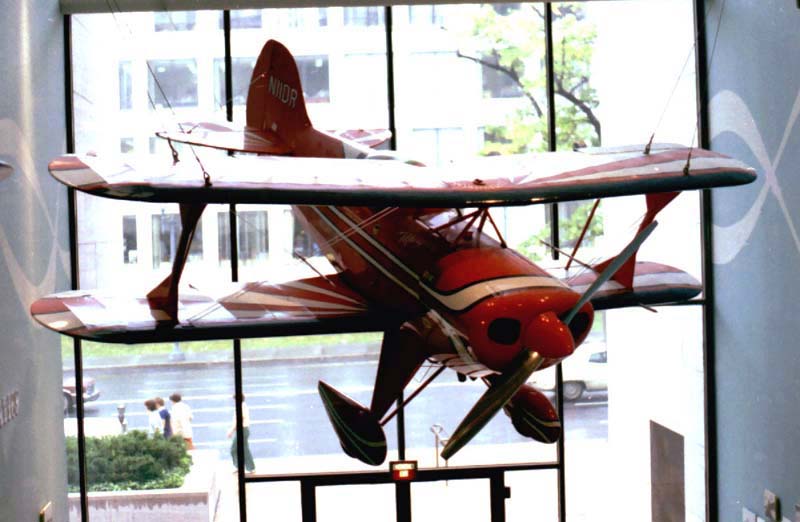The Pitts S-1S Special biplane
reigned as the ultimate competition aerobatic aircraft
in the early 1970s. The U.S. Aerobatic Teams of 1970 and
1972 won the world team championships flying the Pitts
S-1S almost exclusively. It remains one of the world's
most popular aircraft for basic to advanced category
competition, aerobatic training, and sport flying.
In
1960 Curtis Pitts introduced the homebuilt Pitts S-1S as
a more competitive version of the S-1C Pitts Special, a
small but highly maneuverable aerobatic biplane. The
agile S-1S has four ailerons to boost the roll rate, and
its symmetrical airfoils allow it to perform maneuvers
in any orientation. The S-1S went into factory
production in 1972. J. Dawson Ransome built this
airplane in 1969 and donated it to the Museum in 1973.
Variants
S-1
Basic single-seat Pitts aerobatic biplane with a
flat M6 aerofoil section and lower wing ailerons only,
fitted with a variety of engines. Two were built, the
first named Special and the second Li'l
Stinker.
S-1C
Amateur-built S-1 single-seat aircraft, flat bottom
wing with ailerons on lower wing only, designed for
100–180 hp (75–134 kW) engines. First flown in 1960, the
S-1 is currently available as a plans-built aircraft
from Steen Aero Lab.
S-1D
Amateur-built S-1C with ailerons on all four wings,
generally similar to S-1S.
S-1E
Amateur-built S-1C using factory-produced kits. Uses
symmetrical airfoil.
S-1F
Outside derivative homebuilt, with the Falcon wing.
Square tips, 25% more aileron span. In the UK, this
model is fitted with a 200 hp (149 kW) Monty Barrett
engine, and a lightweight Hoffmann VP propeller.
S-1S
Aerotek-built certified S-1C for competition
aerobatics, round aerofoil section, four ailerons and
powered by a 180 hp (134 kW) Lycoming AEIO-360-B4A; 61
built. This model is also available from Aviat Aircraft
as a plans-built aircraft.
S1-SS
Similar to the certified S1-S "Roundwing". 180–200+
hp (134–149 kW), single-seat, homebuilt, symmetrical
wing, four symmetrical "Super-Stinker" style ailerons,
300 degree/s roll rate, fixed pitch propeller. This
model is available in plans and components form from
Steen Aero Lab.
S-1T
Aerotek-built S-1C with a 200 hp (149 kW) Lycoming
AEIO-360-A1E and minor changes; 64 built. Four-aileron,
single-seat, factory-built, symmetrical wing,
symmetrical ailerons, constant speed two- or three-blade
Hartzell propeller. The top wing was moved forward
compared to the S-1S for weight and balance. This model
is in production in 2008 from Aviat Aircraft as an
"on-demand" manufacture product.
S-1-11B
Known as Model 11 "Super Stinker", 300+ hp (220 kW)
Lycoming, four-aileron, single-seat, experimental-plans
or factory-built and factory component parts, symmetric
airfoil, three-blade constant speed prop, rolls better
than 300 degree/s, climbs better than 3,000 ft/min (15.3
m/s).
|

